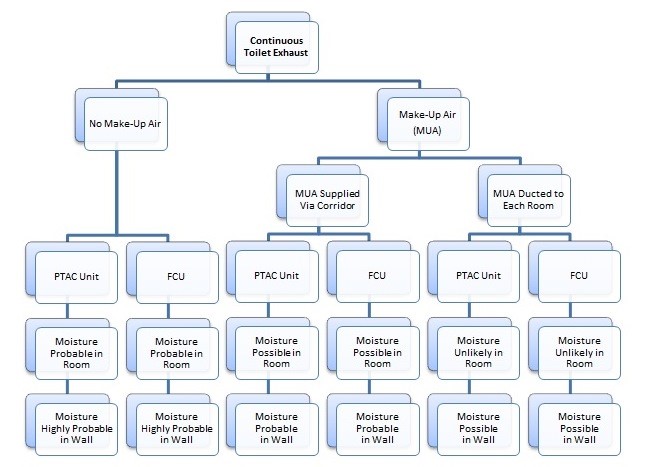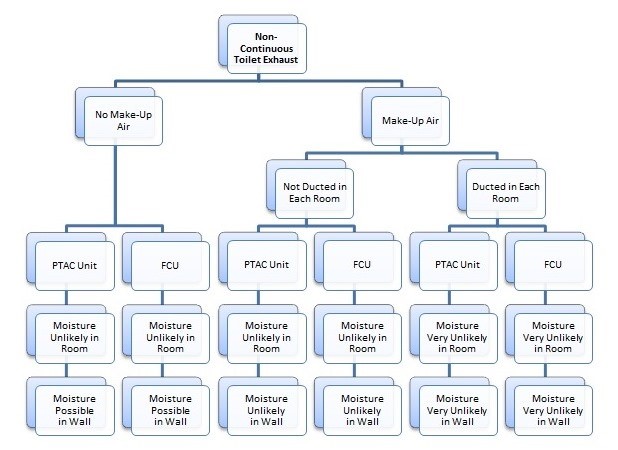Suppose there was a tool that could predict, before a single penny was spent on construction, the likelihood of whether your building would fail. Not only that, but this tool could also provide you with enough information to make significant design changes that would dramatically decrease any risk factors. Would you be interested? Of course you would.
At the risk of oversimplifying a complex process that contains multiple variables, we believe we have created such a tool. The following moisture prediction charts have been adapted from a mold and moisture manual Liberty Building Forensics Group developed for Disney Corporation in the early 1990s. Over the past two decades, they have been beta-tested on literally thousands of hotels, and have proven time and time again to be as true today as they were 20 years ago.
Although the charts were created with hotel guest rooms and wall cavities in mind, the general principles demonstrated would hold true for most buildings. Hotels just happen to be the simplest commercial building structure, so they were the easiest to beta test.
We took as many variables out of the charts as possible to simplify the choices. You will note that the primary difference between the two charts is that Figure 1 reflects Continuous Toilet Exhaust, whereas Figure 2 reflects Non-Continuous Toilet Exhaust. We must add several additional notes for clarification:
- These prediction charts assume no rainwater leaks are present and that all moisture problems are the result of condensation.
- This prediction chart assumes that the hotel is located in a climate where the summertime conditions are hot and humid.
- This prediction chart should be used as a general guideline and not as a specific design tool, since there are various other factors that can dramatically influence whether moisture problems will occur in the guest rooms or inside the wall cavities other than those items that have been identified.
- This chart assumes that local codes will allow the MUA to be supplied via the corridor and door undercuts.
Chart abbreviations and terms are explained as follows:
- PTAC Unit – Package Terminal Air Conditioning (standard wall units)
- FCU – Fan Coil Unit (typically used in upscale hotels)
- MUA – Make-Up Air
- Continuous Toilet Exhaust – typically used in high-rise or five-star hotels
 Figure 1 - Continuous Toilet Exhaust
Figure 1 - Continuous Toilet Exhaust
 Figure 2 - Non-Continuous Toilet Exhaust
Figure 2 - Non-Continuous Toilet Exhaust
A Brief History of Hotel Construction Cycles
Like many other aspects of the construction industry, hotel construction is very cyclical in nature. It tends to follow a decade-long pattern of “boom or bust”: contractors build rapidly to the point that overbuilding occurs, leading to an inevitable crash.
The charts above reflect institutional knowledge gleaned after the building boom cycle of the mid 1980s, when industry experts began to investigate a prolific number of hotel failures. Building owners, designers, and contractors were bewildered; thousands upon thousands of “quality” hotels had been constructed, but many of them were quickly failing – often catastrophically. On the surface, it looked like the cause was nothing more than sheer luck or happenstance. While many theories abounded, the number of variables made it difficult to get to the very root of the issue. Failures were often attributed to the wrong party, such as blaming the contractor rather than the designer.
Ultimately, designers and contractors figured out that if they took certain steps, their building would almost certainly be a success. Other decisions seemed to lead unequivocally to failure. But though they knew that one step typically led to another, they weren’t sure why. In the absence of any building science knowledge, they could only follow observable patterns.
The fundamental problem rested in the fact that building scientists (who understand moisture migration) and building owners, architects, and product manufacturers (who care mostly about outward appearance) didn’t collaborate throughout the construction process. Building scientists ask questions like “What is the likelihood of failure if these design plans are implemented as is?” Design and construction teams, on the other hand, think primarily about motif, cost, speed, and accreditation.
Once the two camps got together and compared notes, cause and effect began to make more sense. The predictability in moisture is staggering.
Looking at a Building’s “Genetic Profile”
To the discerning eye, there are remarkable similarities between the biomed and construction fields. The medical community consistently looks for biomarkers in human DNA structure. This helps them to connect the dots between cause and effect. Even as early as the womb, they are able to know what to expect once that baby comes into the world.
Similarly, a building scientist is able to determine from the outset if a building design has the genetic predisposition for high risk simply by asking a few questions. He sees a binary decision tree. At the fork in the road, if Choice A is selected, this will be the outcome. If Choice B is taken instead, a very different result will ensue. By understanding, interpreting, and applying fundamental scientific laws, he can explain to a building owner or designer why the only way to decrease a particular risk is by modifying an earlier design factor.
Interestingly, studies have shown that high-risk buildings typically cost more than low-risk ones (usually due to their heightened complexity). So ironically, owners end up paying more money only to increase their risk of building failure. We’ve seen this to be true in the hotel industry; more five-star hotels have moisture problems than do three-star hotels.
If a building is going to fail, it usually does so within the first two years (though it may not be discovered for several more years) – often before it officially launches, and usually in a massive, catastrophic manner. We have seen numerous instances of buildings running into multi-million problems before they are even occupied. To use the biological analogy we referenced above, this would be similar to a miscarriage, stillbirth, or even Sudden Infant Death Syndrome. The “newborn” building is suddenly transferred from the nursery to the ICU.
In the medical field (as in construction), there is often a sea of mediocrity populated by islands of expertise. A true medical expert realizes that by conducting amniotic fluid genetic testing while the baby is still in the womb, problems can be predicted and in many cases, fixed before they even happen. This leads to a dramatic change in the outcome.
In the same way, a knowledgeable building scientist can detect what others have overlooked by analyzing a building’s genetic composition prior to its “birth”. An architect should not emulate a master chef, trying a pinch of this and a dash of that, operating under intuition rather than science. The construction industry needs a cookbook, not kitchen tradition or experience. Contractors need to know that this particular recipe calls for 1/2 tsp. of salt and 2 cups of flour. That way, if the recipe goes bad, they can determine what the bad ingredient or measurement was, or trace which two ingredients clashed.
The truth of the matter is that neither designers, building owners, nor product manufacturers can make accurate decisions in the dark. They must be educated about how one predictive factor will lead to an almost certain outcome. Architects must be enlightened that if they go back to the drawing board and alter one choice early on, everything else will be much more forgiving down the road. On the other hand, if they choose a continuous toilet exhaust system vs. a non-continuous toilet exhaust system, for example, every other choice along the way has to be perfect. There is no room for forgiveness built in. While one bad decision may lead to a moisture problem, two or three bad decisions can end up being catastrophic. In essence, the charts above are an architect’s or building owner’s “Get Out of Jail Free” card.
Click here to read a more comprehensive blog on this issue.
Download our free e-book on “The Single Most Important Factor
in Reducing the Risk of a Mold and Moisture Lawsuit in Your Next Project.”
About the Author
J. David Odom was a Senior Building Forensics Consultant with Liberty Building Forensics Group. He has managed some of the largest and most complex mold and moisture problems in the country, including the $60M construction defect claim at the Hilton Hawaiian Village in Honolulu and the $20M claim at the Martin County Courthouse. He has also managed over 500 projects for the Walt Disney Corporation dating back to 1982 that have included technical issues related to corrosion, moisture, and design & construction defect-related problems. He has published numerous manuals and technical articles, including a monograph on moisture and mold for the National Council of Architectural Registration Boards (NCARB).
LBFG has provided mold and moisture diagnoses and solutions for buildings to owners, contractors, and developers worldwide. The firm has project experience in the U.S., Canada, Mexico, the Caribbean, Central America, the Middle East, Southeast Asia, and Europe. For more information about how Liberty can help you avoid catastrophic mold and moisture problems on your project, contact George DuBose, CGC at g.dubose@libertybuilding.com or by phone at 407/467-5518.
More from Author
J. David Odom | Aug 27, 2018
The 3 myths of PTAC units
Over the past 30 years, building experts at Liberty Building Forensics Group (LBFG) have investigated hundreds of hotel moisture problems (involving thousands of guest rooms) and in the process, have observed three repetitive assumptions that appear to be completely ignored by the hospitality industry.







